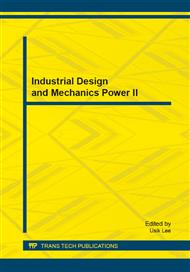[1]
Ye Chao, Ning Zhaoyuan, Jiang Meifu, et al. Diagnostic theory and technique of plasma of low pressure and low temperature. Science Press. (2010).
Google Scholar
[2]
QiJing. Studies on the Mechanism of laser induced material breakdown and the formation of plasma. Nanjing University of Science & Technology. 2009. 06.
Google Scholar
[3]
A Behjat, G J Tallents, D Neely. The characterization of a high-density gas jet. J. Phys. D: Appl. Phys. 30(1997) 2872-2879.
DOI: 10.1088/0022-3727/30/20/014
Google Scholar
[4]
L.A. Doyle, G.W. Martin, T.P. Williamson, et al. Three-Dimensional Electron Number Densities in a Titanium PLD Plasma Using Interferometry. IEEE TRANSACTIONS ON PLASMA SCIENCE, VOL. 27, NO. 1, FEBRUARY (1999).
DOI: 10.1109/27.763085
Google Scholar
[5]
Akihiro Fukui, Koichi Kawamura, Kimiya Komurasaki, et al. LSD Termination Conditions and Post-Shock Electron Density. 45th AIAA Aerospace Sciences Meeting and Exhibit, 8-11 January 2007, Reno, Nevada.
DOI: 10.2514/6.2007-1189
Google Scholar
[6]
Wu Ying. Studies on microwave interference and microwave diagnosis of laser-induced plasma. Nanjing University of Science & Technology. 2009. 10.
Google Scholar
[7]
C. Aragón, J.A. Aguilera. Characterization of laser induced plasmas by optical emission spectroscopy: A review of experiments and methods. Spectrochimica Acta Part B 63 (2008) 893-916.
DOI: 10.1016/j.sab.2008.05.010
Google Scholar
[8]
Zhang Baohua, Liu Wenqing, Cui Zhifeng. Time and Spatial Evolution of the Electron Density in Laser-Induced Co Plasmas. Chinese Journal of Lasers. Vol. 35, No. 10. 2008. 10.
DOI: 10.3788/cjl20083510.1485
Google Scholar
[9]
Zhang Lin, Tang Zhiping, Tong Huifeng, et al. Spectrum diagnoses of laser plasma in Ablation Mode, laser propulsion. Journal of Atomic and Molecular Physics. Vol. 24, No. 6. 2007. 12.
Google Scholar
[10]
Zhang Ling. Mechanism Investigation of Laser Propulsion with Solid Propellant. University of Science and Technology of China. 2008. 05.
Google Scholar
[11]
P.K. Diwakar, D.W. Hahn. Study of early laser-induced plasma dynamics: Transient electron density gradients via Thomson scattering and Stark Broadening, and the implications on laser-induced breakdown spectroscopy measurements. Spectrochimica Acta Part B 63 (2008).
DOI: 10.1016/j.sab.2008.07.003
Google Scholar
[12]
J.J. Camacho, L. Díaz, M. Santos, et al. Time-resolved optical emission spectroscopic measurements of He plasma induced by a high-power CO2 pulsed laser. Spectrochimica Acta Part B 66 (2011) 57-66.
DOI: 10.1016/j.sab.2010.12.001
Google Scholar
[13]
Zhang Jialiang. Emission Spectroscopy Methodology for Low Temperature Discharge Plasma of Low Pressure Gas. Dalian University of Technology. 2002. 05.
Google Scholar


